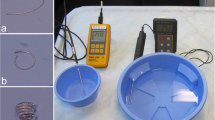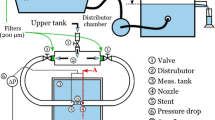Abstract
Gianturco stainless steel coils were discharged into clear plastic tubes of varying sizes and subjected to pulsatile flow in order to study their behavior in a controlled, in vitro environment. When coils are too small for a given vessel, they tend to migrate distally or even proximally. Coils that are too large tend not to reform completely, limiting their cross-sectional area and potentially affecting their occlusive potential. Thus, each coil was tested in tubes of varying sizes and evaluated with regard to positional stability and extent of reformation.
Similar content being viewed by others
References
Wallace S, Gianturco C, Anderson J, Goldstein H, Davis L, Bree R (1976) Therapeutic vascular occlusion utilizing steel coil technique: Clinical applications. AJR 127:381–387
Chuang V, Wallace S, Gianturco C (1980) A new improved coil for tapered-tip catheter for arterial occlusion. Radiology 135:507–509
Anderson J, Wallace S, Gianturco C, Gerson P (1979) “Mini” Gianturco stainless steel coils for transcatheter vascular occlusion. Radiology 132:301–303
Author information
Authors and Affiliations
Rights and permissions
About this article
Cite this article
Nancarrow, P.A., Fellows, K.E. & Lock, J.E. Stability of coil emboli: An in vitro study. Cardiovasc Intervent Radiol 10, 226–229 (1987). https://doi.org/10.1007/BF02593876
Published:
Issue Date:
DOI: https://doi.org/10.1007/BF02593876




